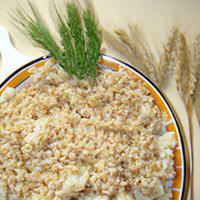
1 serving (100 grams) contains 123 calories, 2.3 grams of protein, 0.4 grams of fat, and 28.2 grams of carbohydrates.

Log this food in SnapCalorie

Nutrition Information
Calories |
246 | ||
|---|---|---|---|
% Daily Value* |
|||
| Total Fat | 0.8 g | 1% | |
| Saturated Fat | 0.2 g | 1% | |
| Polyunsaturated Fat | 0 g | ||
| Cholesterol | 0 mg | 0% | |
| Sodium | 6 mg | 0% | |
| Total Carbohydrates | 56.4 g | 20% | |
| Dietary Fiber | 7.6 g | 27% | |
| Sugars | 0.4 g | ||
| protein | 4.6 g | 9% | |
| Vitamin D | 0 mcg | 0% | |
| Calcium | 22 mg | 1% | |
| Iron | 2.6 mg | 14% | |
| Potassium | 186 mg | 3% | |
* Percent Daily Values are based on a 2,000 calorie diet. Your daily values may be higher or lower depending on your calorie needs.
Food Attributes
Source of Calories
About Pearl barley cooked
Pearl barley, a type of hulled barley polished to remove its outer layers, is a versatile whole grain enjoyed worldwide, particularly in European, Middle Eastern, and Asian cuisines. Once cooked, it has a soft, chewy texture and a nutty, earthy flavor. Rich in fiber, pearl barley supports digestive health and helps maintain steady energy levels. It contains several nutrients, including B vitamins, selenium, and magnesium, essential for energy production and antioxidant functions. While slightly lower in fiber than the unpolished variety, it remains a heart-healthy option and is low in fat. Its high glycemic index means moderating intake may be beneficial for individuals managing blood sugar. Popular in soups, risottos, and salads, cooked pearl barley serves as a satisfying and nutrient-dense alternative to rice or pasta.



